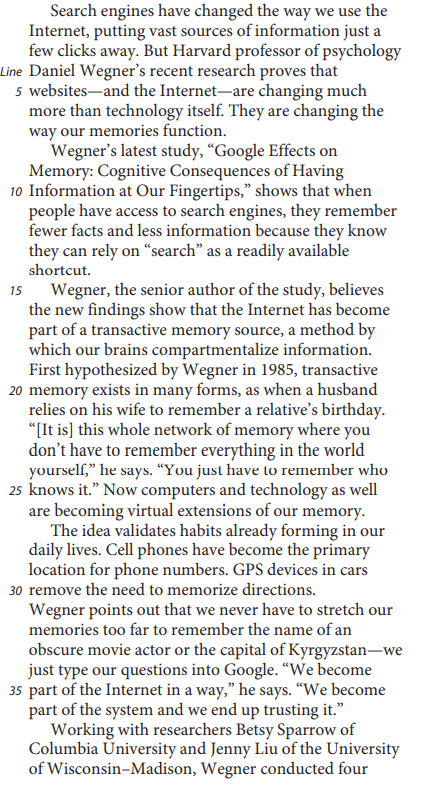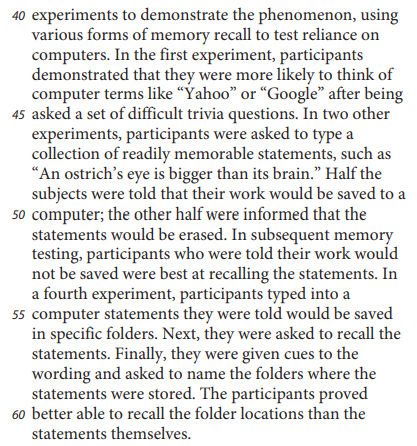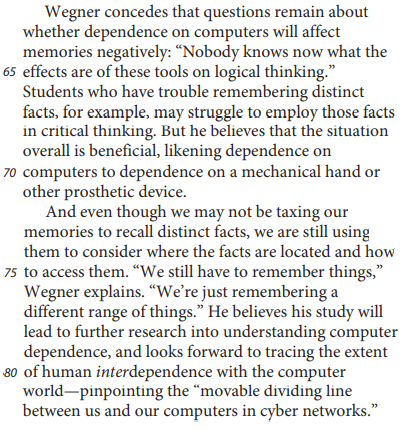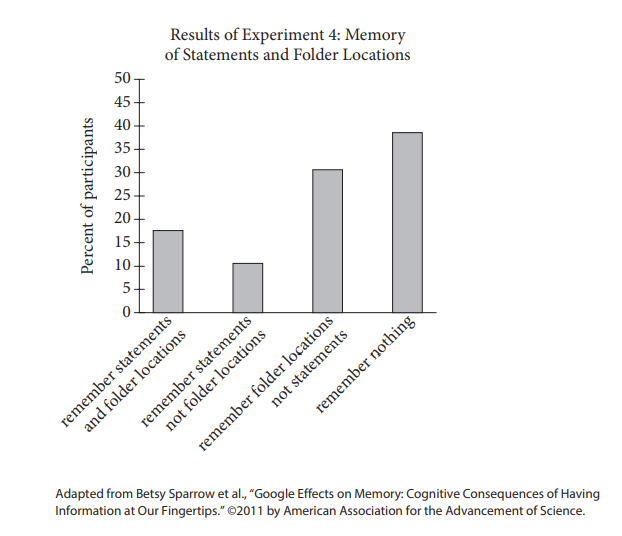SAT (Scholastic Assessment Test) is a standard test, used for taking admission to undergraduate programs of universities or colleges of the United States. SAT is developed and published by the College Board, an organization in the United States, administered by the Educational Testing Service. In this article of AKVTutorials, you will get SAT Reading Practice Test 42 | SAT 2024 Online Tutor AMBiPi.
SAT Reading Practice Passage
This passage is adapted from “How the Web Affects Memory.” ©2011 by Harvard Magazine Inc.




SAT Reading Comprehension Practice Test Questions
SAT Practice Test 42 Question No 1
The main purpose of the passage is to
Option A: describe a series of experiments on the way technology interferes with critical thinking.
Option B: assert that people have become overly dependent on computers for storing information.
Option C: discuss the idea that humans’ capacity for memory is much weaker than it once was.
Option D: share the findings of a study examining the effect of computer use on memory recall.
SAT Practice Test 42 Answer No 1
Show/Hide Answer
Option D :
The first paragraph of the passage introduces research by Harvard psychology professor Daniel Wegner demonstrates that the Internet is changing “the way our memories function.” One finding of Wegner’s study, as stated in the second paragraph, is that “when people have access to search engines, they remember fewer facts and less information because they know they can rely on ‘search’ as a readily available shortcut.” In the third paragraph, Wegner claims that his study shows how “the Internet has become part of a transactive memory source, a method by which [humans’] brains compartmentalize information,” such that “computers and technology as well are becoming virtual extensions of [human] memory.” The remainder of the passage details Wegner’s experiments and findings. Thus, the main purpose of the passage is to share the findings of a study examining the effect of computer use on memory recall.
Choice A is incorrect. Although the author suggests in the sixth paragraph that technology may interfere with critical thinking, this isn’t the focus of Wegner’s experiments, nor is illustrating this position the main purpose of the passage. Choices B and C are incorrect because the passage doesn’t support the assertion that people have become overly dependent on computers for storing information (choice B) or that humans’ capacity for memory is much weaker than it once was (choice C).
SAT Practice Test 42 Question No 2
Which choice best supports the idea that reliance on computers does not necessarily diminish human memory?
Option A: Lines 3-6 (“But Harvard… itself”)
Option B: Lines 31-33 (“Wegner… Kyrgyzstan”)
Option C: Lines 66-68 (“Students… thinking”)
Option D: Lines 72-75 (“And even… them”)
SAT Practice Test 42 Answer No 2
Show/Hide Answer
Option D :
The fifth paragraph details the results of the fourth experiment of Wegner’s study, where participants were more likely to recall digital folder locations where statements they typed were saved than the actual statements themselves. The first sentence of the last paragraph summarizes why this result may not be alarming: “And even though we may not be taxing our memories to recall distinct facts, we are still using them to consider where the facts are located and how to access them.” In this sentence, the author paraphrases Wegner’s view that although human memory is changing as a result of technology, this doesn’t indicate that human memory is declining, as people are relying on their memory to access specific types of information. Therefore, this sentence best supports the idea that reliance on computers doesn’t necessarily diminish human memory.
Choices A, B, and C are incorrect because the cited lines don’t support the idea that reliance on computers doesn’t necessarily diminish human memory. Instead, they introduce the topic of Wegner’s research (choice A), provide examples of the types of information that people may now rely on the Internet to provide (choice B), and concede that the Internet may diminish critical thinking skills (choice C).
SAT Practice Test 42 Question No 3
In context, the reference to remembering a relative’s birthday mainly serves to
Option A: show that people who are closely related tend to have shared memories.
Option B: demonstrate how people initially developed external sources of memory.
Option C: emphasize the effectiveness and accuracy of transactive memory sources.
Option D: illustrate the concept of a transactive memory source using a familiar situation.
SAT Practice Test 42 Answer No 3
Show/Hide Answer
Option D :
In the third paragraph, the author outlines Wegner’s theory of a “transactive memory source.” According to Wegner, transactive memory is a “network of memory,” where an individual can access information that he or she can’t personally recall from a particular source. The author illustrates this idea in the second sentence of this paragraph, with the example of “a husband [who] relies on his wife to remember a relative’s birthday.” Thus, the reference to remembering a relative’s birthday mainly serves to illustrate the concept of a transactive memory source using a familiar situation.
Choice A is incorrect. Although the situation of a husband relying on his wife’s memory does suggest that closely related people tend to have shared memories, this isn’t the main purpose of this reference in the context of the passage. Choice B is incorrect because the example doesn’t demonstrate how people initially developed external sources of memory. Choice C is incorrect because the function of the example isn’t to emphasize the effectiveness and accuracy of transactive memory sources. Instead, its function is to make the abstract concept of transactive memory more easily understandable.
SAT Practice Test 42 Question No 4
Based on the information in the passage, which of the following would be considered a transactive memory source?
Option A: A souvenir brought home from a memorable trip
Option B: A written list of a user’s passwords for different websites
Option C: A library database that helps users locate specific books
Option D: A website that helps users plan and makes travel arrangements
SAT Practice Test 42 Answer No 4
Show/Hide Answer
Option B :
In the third paragraph, Wegner describes transactive memory as a “network of memory where you don’t have to remember everything in the world yourself.” Instead, the burden of storing information is shifted to transactive memory sources that can function as “extensions of [human] memory.” Examples of sources provided in the fourth paragraph of the passage include cell phones, GPS devices, and search engines. What these examples have in common is that they store information, such as phone numbers, directions, and general knowledge, so that a person doesn’t have to commit this information to memory. A written list of a user’s passwords for different websites serves the same function as these examples. Although remembering a list of passwords for different websites is conceivable without a list, keeping such a list shifts the burden of storing readily memorable information away from the user because the list preserves the information in place of the user’s memory. Therefore, based on the passage, a written list of a user’s passwords for different websites would be considered a transactive memory source.
Choices A, C, and D are incorrect because they don’t accurately exemplify transactive memory sources. A souvenir brought home from a memorable trip (choice A) may evoke memories of that place for the owner. However, it doesn’t preserve actual information in the way the examples provided in the passage do. A library database that helps users locate specific books (choice C) may seem similar to a search engine. However, it doesn’t store information that would otherwise be readily memorable in the way that a search engine can help a user remember an actor’s name or detail of geography, according to the fourth paragraph of the passage. Instead, it helps a library patron navigate a system that is typically far too vast to be committed to memory. A website that helps users plan and makes travel arrangements (choice D) may help facilitate transactions in the form of ticket purchases or hotel reservations. However, it doesn’t store information that the user would otherwise memorize.
SAT Practice Test 42 Question No 5
As used in line 26, “extensions of” most nearly means
Option A: delays in.
Option B: additions to.
Option C: lengths to.
Option D: developments of.
SAT Practice Test 42 Answer No 5
Show/Hide Answer
Option B :
In the last sentence of the third paragraph, the author states that “computers and technology . . . are becoming virtual extensions of our memory.” In other words, computers and technology are becoming memory sources that serve as additions to human memory. Thus, “extensions of,” as used in the passage, most nearly means additions to.
Choices A, C, and D are incorrect because in the context of the passage, “extensions of” means additions to, not delays in (choice A), lengths of (choice C), or developments of (choice D).
SAT Practice Test 42 Question No 6
The discussion of the experiments suggests that people are inclined to think of specific information sources in response to being
Option A: required to memorize details that will then be made inaccessible.
Option B: directed to develop a system for organizing and saving content.
Option C: asked to provide facts that are not already familiar to them.
Option D: prompted to identify terms related to dependence on computers.
SAT Practice Test 42 Answer No 6
Show/Hide Answer
Option C :
The fifth paragraph of the passage describes four experiments that Wegner conducted to demonstrate his theory of a transactional memory source. The first experiment, described in the second sentence of this paragraph, found that participants “were more likely to think of computer terms like ‘Yahoo’ or ‘Google’ after being asked a set of difficult trivia questions.” The second, third, and fourth experiments explored participants’ tendency to remember the location of information rather than the information itself. Therefore, the discussion of the experiments, most specifically the first experiment, suggests that people are inclined to think of specific information sources in response to being asked to provide facts that aren’t already familiar to them.
Choice A is incorrect. Although some of the subjects in the second experiment did memorize information that later became inaccessible, this act of memorization didn’t cause the subjects to think of specific information sources. Choice B is incorrect. Although participants in the fourth experiment were told their work would be saved in specific folders, they weren’t directed to develop a system for organizing and saving content. Choice D is incorrect because none of the experiments involved participants being prompted to identify terms related to dependence on computers.
SAT Practice Test 42 Question No 7
Which choice provides the best evidence for the answer to the previous question?
Option A: Lines 42-45 (“In the… questions”)
Option B: Lines 48-51 (“Half… erased”)
Option C: Lines 51-53 (“In subsequent… statements”)
Option D: Lines 59-61 (“The participants… themselves”)
SAT Practice Test 42 Answer No 7
Show/Hide Answer
Option A :
The previous question asks, based on Wegner’s experiments when people would be inclined to think of specific information sources. The answer, that being asked to provide facts that aren’t already familiar to them provokes this response, is best supported by the second sentence of the fifth paragraph: “In the first experiment, participants demonstrated that they were more likely to think of computer terms like ‘Yahoo’ or ‘Google’ after being asked a set of difficult trivia questions.”
Choices B, C, and D are incorrect because the cited lines don’t support the answer to the previous question. Instead, they describe the different parameters for the participants in the second and third experiments (choice B), summarize the results of the second and third experiments (choice C), and summarize the results of the fourth experiment (choice D).
SAT Practice Test 42 Question No 8
As used in line 67, “employ” most nearly means
Option A: utilize.
Option B: enroll.
Option C: exert.
Option D: assign.
SAT Practice Test 42 Answer No 8
Show/Hide Answer
Option A :
The second sentence of the sixth paragraph states: “Students who have trouble remembering distinct facts, for example, may struggle to employ those facts in critical thinking.” In other words, students who find it difficult to remember information may find it challenging to utilize that information to develop logical arguments. Therefore, the word “employ,” as used in the context of this sentence most nearly means to utilize.
Choices B, C, and D are incorrect because in the context of the passage, “employ” means utilize, not enroll (choice B), exert (choice C), or assign (choice D).
SAT Practice Test 42 Question No 9
According to the graph, approximately what percentage of participants remembered both parts of the information given to them during the fourth experiment?
Option A: 7%
Option B: 10%
Option C: 17%
Option D: 30%
SAT Practice Test 42 Answer No 9
Show/Hide Answer
Option C :
The passage explains that in the fourth experiment participants were given statements and folder locations where they were told those statements would be saved. On the graph, the bar farthest to the left represents those who remembered both elements of the information given to them during the experiment. This bar rises to a point midway between 15% and 20%. Therefore, according to the graph, approximately 17% of participants remembered both parts of the information given to them during the fourth experiment.
Choice A is incorrect because none of the groups represented on the graph comprised 7% of participants. Choices B and D are incorrect because neither 10% (choice B) nor 30% (choice D) of participants remembered both elements of the information given to them during the fourth experiment. Instead, 10% remembered statements but not folder locations (according to the second bar from the left), while 30% remembered folder locations but not statements (according to the the third bar from the left).
SAT Practice Test 42 Question No 10
Based on the description of Wegner’s fourth experiment, what is the most likely explanation for the findings for the largest single group of participants represented in the graph?
Option A: Those participants focused on remembering the folder locations.
Option B: Those participants attempted to remember the statements and the folder locations.
Option C: Those participants did not attempt to remember any specific pieces of information.
Option D: There is not enough information to determine the cause of the results for those participants.
SAT Practice Test 42 Answer No 10
Show/Hide Answer
Option D :
The largest single group of participants represented on the graph is composed of those who remembered nothing, as indicated by the bar that is farthest to the right. Why approximately 40% of participants could not remember the statements or the folder locations isn’t explained by the description of the fourth experiment in the fifth paragraph of the passage. Therefore, the most likely explanation for the findings regarding the largest single group of participants represented on the graph is that there isn’t enough information to determine the cause of the results for those participants.
Choices A, B, and C are incorrect because these speculations aren’t supported by the passage. There isn’t enough information provided about the fourth experiment to know whether the participants who could remember nothing focused on remembering the folder locations (choice A), attempted to remember the statements and the folder locations (choice B), or didn’t attempt to remember any specific pieces of information (choice C).



